Inspired by next week’s RHS Chelsea Flower Show, we take a look around some of the nation’s best gardens…
Stowe
The house and garden of Stowe in Buckinghamshire is a prime example of just how exquisite British gardens can be. The garden itself is home to 40 historic temples and monuments and was Capability Brown’s first major commission. In the 18th century British gardens took a step away from formality. Gardens became more naturalistic and one of the earliest examples of the new approach was this garden at Stowe by Sir Richard Temple, Lord Cobham. Stowe was also one of the first English gardens to make use of the ha-ha. This concept protected the grounds from neighbouring livestock with a ditch that did not impede on the view.
Biddulph Grange
The gardens of Biddulph Grange in Staffordshire are a fine example of a 19th-century garden. Victorian gardens at the time were a showcase of new discoveries – often in the form of new exotic plants – and a celebration of the adventurous spirit of the British Empire. Biddulph Grange was created by James Bateman for his collection of plants from around the world. It is home to the oldest surviving Golden Larch tree in Britain, which was bought over from China in the 1850s. Stone used in the Mosaic Parterre section of the garden was a terracotta and yellow grog (crushed, unglazed pottery – don’t worry we had to look it up too) from the neighbouring potteries that the area is renowned for. The Chinese Garden with its temples and zigzagged wooden fences was inspired by the Willow Pattern on the famous blue and white plates.
nationaltrust.org.uk/biddulph-grange-garden
Nymans
Nestled in the heart of West Sussex, Nymans is a discreet Edwardian garden. Curating a garden was a competitive feat at the time and Nyman’s owners, the Messels, had the standards of neighbouring gardens – The High Beeches, South Lodge and Wakehurst Place – to live up to. The garden features a kitchen garden, a rock garden, a rose garden and a heather garden; inspired by the heather grown at King William’s Temple at the Royal Botanic Gardens Kew. James Comber, the head gardener, recieved the Victoria Medal of Honour from the Royal Horticultural Society, which is their highest accolade.
Great Dixter
Great Dixter in East Sussex was the family home of gardener and gardening writer Christopher Lloyd. When the Lloyd family arrived at the house in 1910, there was only a few orchards and trees surrounding it. The Great Dixter you see today is a prime example of a 20th century garden. It was designed by the renowned architect Edwin Lutyens and has classic features like the Peacock Garden with its topiary birds and beautiful borders that burst with colour.
Wrest Park
The gardens at Wrest Park are a unique blend of French, English, Dutch and Italian styles from the last three centuries. The 90-acre site tells the story of the de Greys family who created a landscape to reflect their status and political allegiance through its serpentine waterways, classical buildings and statues and extensive woodland. The Long Water, which stretches out away from the main house, is one of the original features inspired by the formal canals at Versailles. At the other end of the water is the stunning, Baroque pavilion designed by Thomas Archer, which was used for taking tea and entertaining hunting parties.
englishheritage.org.uk/wrest-park
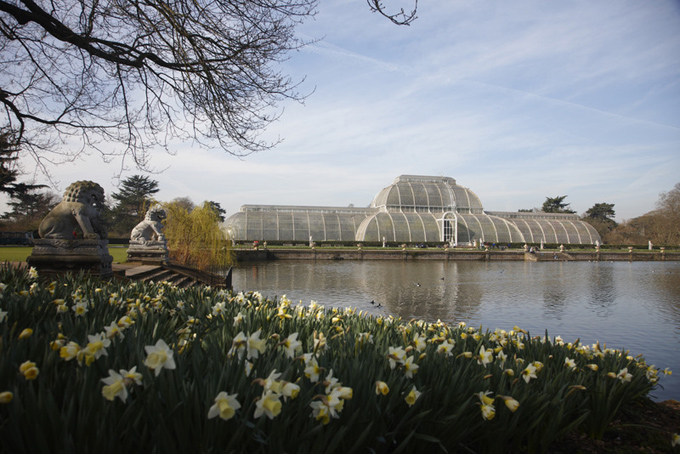
Kew Gardens
Situated west of London in the Royal Borough of Kew, the Royal Botanic Gardens – commonly known as Kew Gardens – is the finest garden in London. Prince Frederick and Princess Augusta, future parents of King George III, started a garden around their palace in Kew in the 18th century and in 1759, William Aiton from the Chelsea Physic Garden was called in to help manage the small garden, which quickly developed and was used for both gardeners and scientists to experiment with plants and landscaping. The 45 years between 1841 and 1855 saw Kew grow to feature the glasshouses and the Palm House that it is renowned for today and when the railway was introduced it started to become a real attraction for tourists.
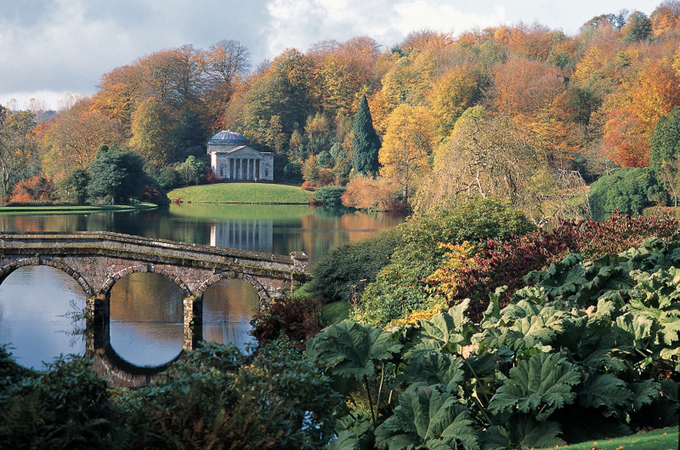
Stourhead
Designed by Henry Hoare II, the garden at Stourhead was described as a ‘living work of art’ by a magazine when it first opened in the 1750s. It is an 18th century landscaped garden speckled with grottoes and classical temples. The garden was at the forefront of the landscape garden design movement.
nationaltrust.org.uk/stourhead
RHS Gardens Rosemoor
Rosemoor is the famous garden at the home of Lady Anne Palmer. She became interested in gardening during her recuperation in Spain after a bout of measles in the 1950s. She travelled widely around the world to learn about different plants and began her own garden at Rosemoor, which is now home to over 4,000 plants. This side of the garden is an informal collection of her beautiful collection and the newer side of the garden, taken on by the Royal Horticultural Society, features a formal decorative garden in a glorious woodland setting.
Hyde Hall Gardens
Hyde Hall began life as a humble garden with six trees. Its owners Dr and Mrs Robinson took on the challenge to transform Hyde Hall into the beautiful garden it is today. The Courtyard Gardens, which illustrate the ever popular cottage-garden style of planting, are popular with visitors. The sweeping views that the hilltop provides today add to the beautiful vistas of the garden.
RHS Garden Wisley
Wisley was the creation of George Fergusson Wilson, the businessman, scientist, inventor, keen gardener and former Treasurer of the RHS. It all began with his experimental garden called Oakwood where he tried to make difficult plants grow with success. The present Wild Garden has descended from this and has seen lilies, Japanese irises and water plants over the years and still holds on to its original concept. Wisley was originally an ornamental garden but it has played a large educational role within the RHS too.
Related articlesSissinghurst in photos |
Click here to subscribe! |
|
|||||||||||||||||

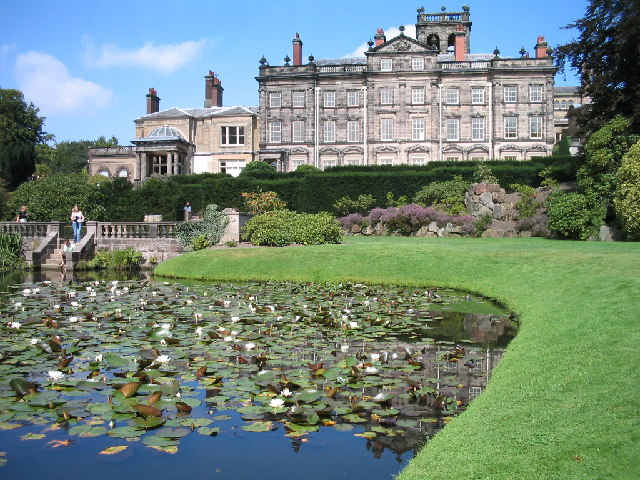
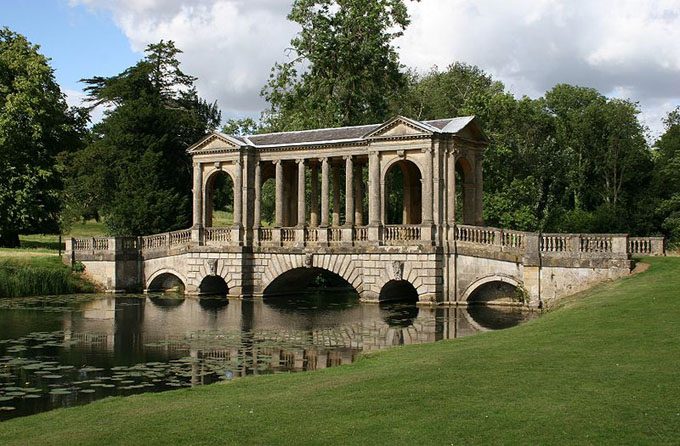
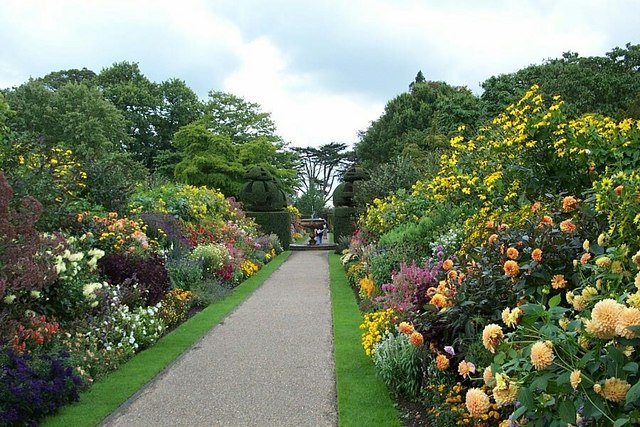







 © 2024
© 2024